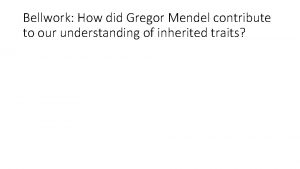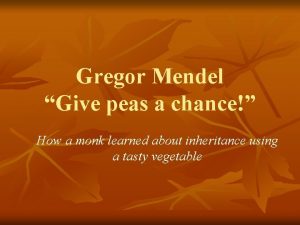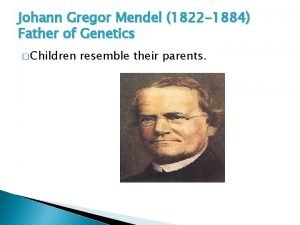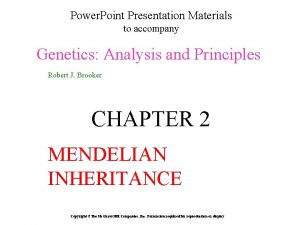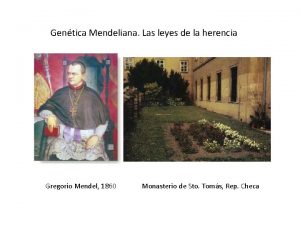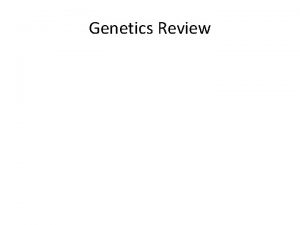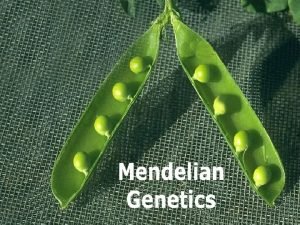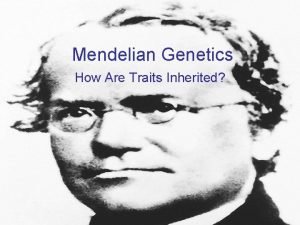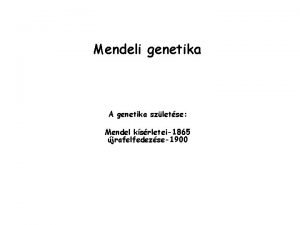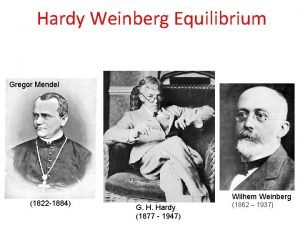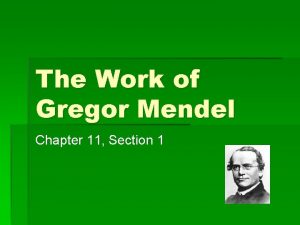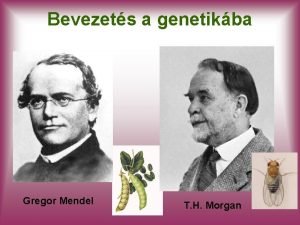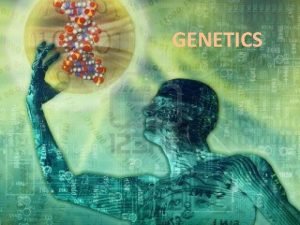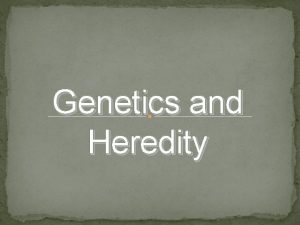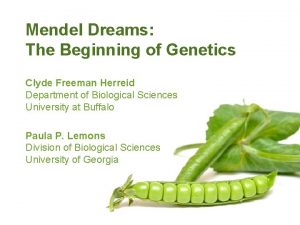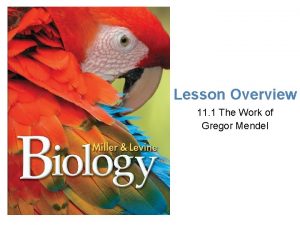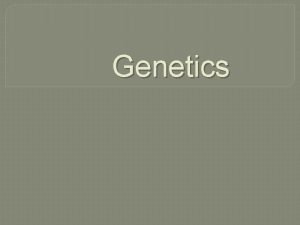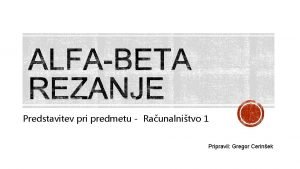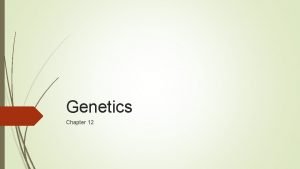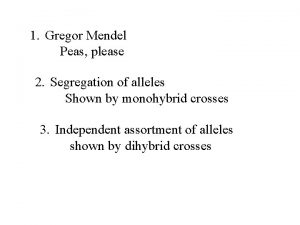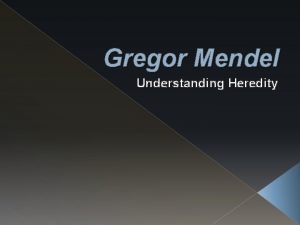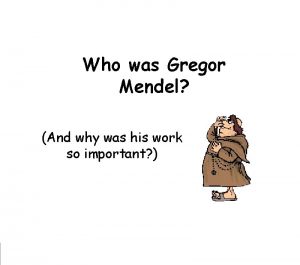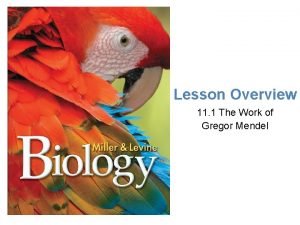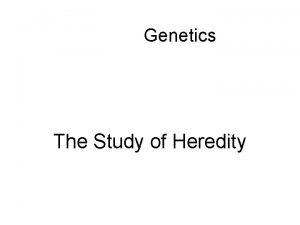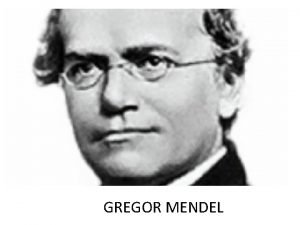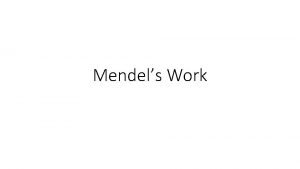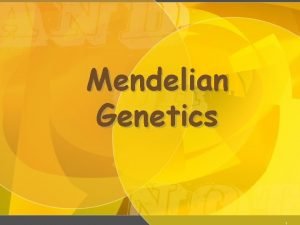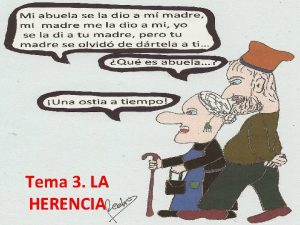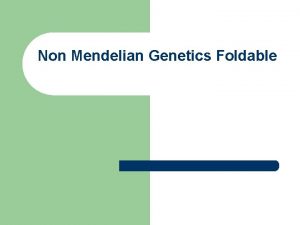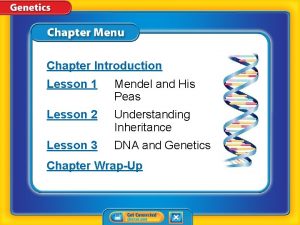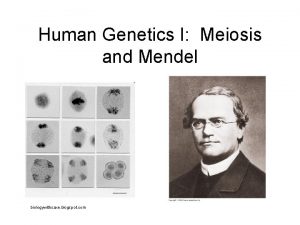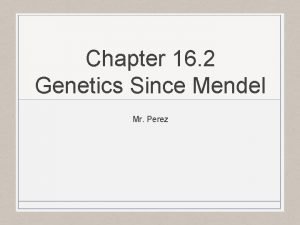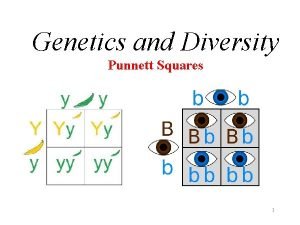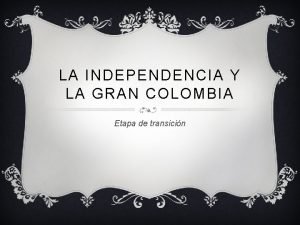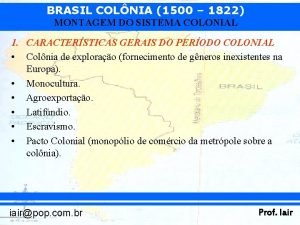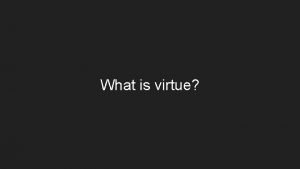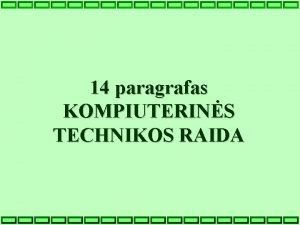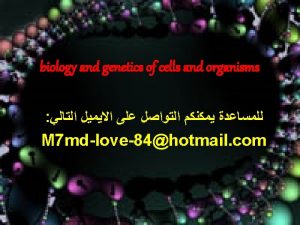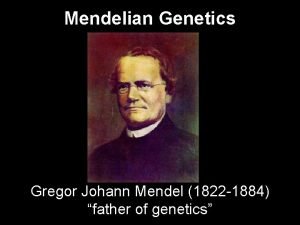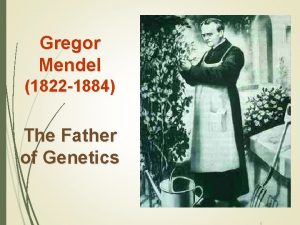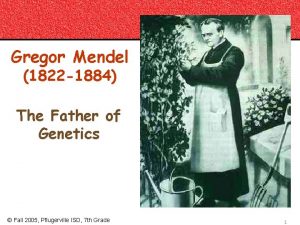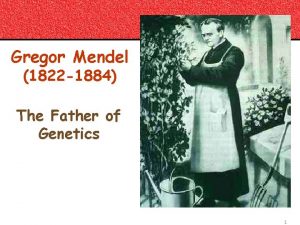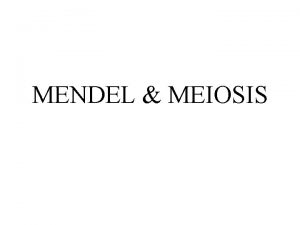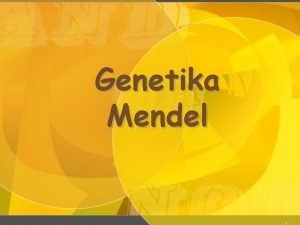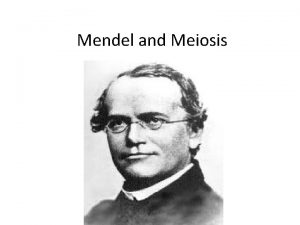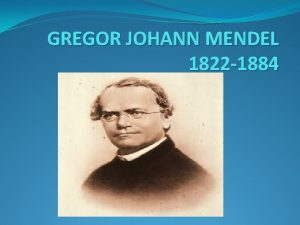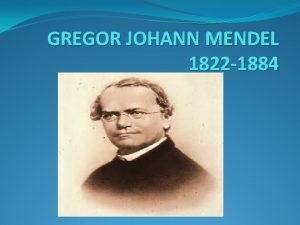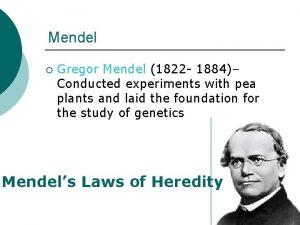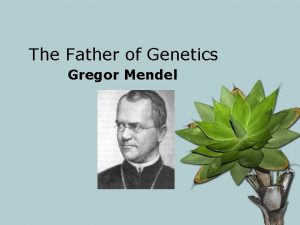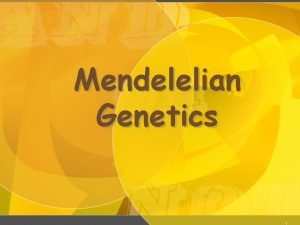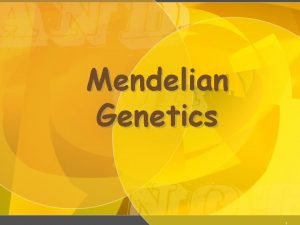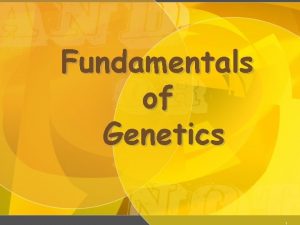Gregor Mendel The father of Genetics 1822 1884






















































- Slides: 54

Gregor Mendel “The father of Genetics” 1822 - 1884 Mendel was experimenting with flowers in Czechoslovakia, in the monastery's gardens, trying to develop new color variations. It was these experiments that led to his experiments in hybridization. One belief was that traits were stored as 'particles' in the parts of each parent's body and 'blended' in the offspring. This theory left many questions un-tackled, however.

Why pea plants? MENDEL chose a common garden pea (Pisum) for his first experiments in hybridization. • "Mendelian Traits" - traits which occur in a very simple form. • Occurs either in one variation or another, with no inbetween. • 287 crosses between 70 different purebred plants. • Approximately 28, 000 pea plants were used! • This does not take into account the other species of plants he experimented on!


3 Steps in his Experiment 1. Self Fertilization = Pure Bred P generation = Parental Generation 2. Cross fertilization - hybrid F 1 generation = First generation (filius- son / fila-daughter) 3. Cross F 1 generation - two hybrids Produced 929 F 2 Plants 705 purple (76%) and 224 White (24%)

Match the terms on your note sheet. Homozygous Alleles law of segregation Punnett Square Recessive Genotype Heterozygous Phenotype Dominant

Concepts learned from Mendel Alleles – Alternate forms of a gene. (P) or (p) Dominant – The allele that is expressed. (P) Recessive – Allele is present, but unexpressed unless both alleles are recessive. (p) Homozygous – Both alleles are the same (PP or pp) Heterozygous – Alleles are different. (Pp) Phenotype – the physically expressed trait. (purple or white) Genotype – The genetic make of the organism. (PP, Pp, pp) law of segregation, alleles separate, when the F 1 generation produces gametes.

Punnett Squares- A punnett square indicates the PROBABILITY of what the offspring from two individuals will look like Steps to solve punnett squares: 1. Define the trait (P=purple p= white) 2. Identify the parents 3. Set-up the punnett square 4. Complete the cross 5. Determine ratios

Meiosis

Cross two hybrid purple flowers 1. Define the trait P= Purple p= white 2. What are the parents Pp x Pp genotypes? 3. Set-up the cross 4. Perform cross 5. Determine ratios ---- P p P PP Pp pp Genotypic ratio: 1 PP: 2 Pp: 1 pp Phenotypic ratio 3 Purple 1: white

Monohybrid Cross • A cross involving a simple Mendelian trait. • A mother has a pure dominant genotype (RR) for rolling her tongue. The father is hybrid (Rr) for this trait. A punnett square will show the possible offspring for each trait. R R Genotypic ratio- 1 RR: 1 Rr R RR RR Phenotypic ratio – r Rr Rr 1 Roller: 0 non-roller

A man, heterozygous for tasting PTC, is crossed with a woman who can also taste PTC. However, their 15 year daughter can not taste PTC. How can this be possible? • Phenylthiocarbamide, also known as PTC • About 70% of people can taste PTC • Used for paternity tests before DNA testing. T t T TT Tt tt Genotypic ratio: 1 TT: 2 Tt: 1 tt Phenotypic ratio: 3 Taster: 1 non-taster

Practice Problem • Maya has a hitchhiker's thumb, a dominant trait. As a matter of fact, she is a pure bred. She decides she wants a child some day with straight thumbs. Is this possible?

Next Hypothesis Are 2 traits always passed on together, or are they independent of one another? Example: Flower color and seed coat Will purple flowers always produce wrinkled seeds? Conclusion: Law of independent Assortment – genes for different traits segregate independently of one another during gamete formation.

Cross a pure breeding round yellow plant (RRYY) with a wrinkled green plant (rryy) 1 Rr. Yy: 0 1 Round yellow: 0 RY ry Rr. Yy RY RY RY

Now complete the cross of two F 1 plants. What are the parents genotypes?

Possible gametes for Rr. Yy RY RY Ry r. Y ry


Practice with gametes • What is the genotype of a wrinkled yellow(YY) pea plant? rr. YY • What are the possible gametes? All are r. Y • What is the genotype of a heterozygous Round yellow (YY) pea plant? Rr. YY • What are the possible gametes? RY or r. Y • What are (is) the possible genotype(s) for a wrinkled green pea plant? rryy • What are the possible gametes? All are ry

Exceptions to Mendel’s Rules • Even though Mendel did a tremendous job teaching us about genetics there are some exceptions to his work. Some alleles are neither dominant nor recessive, and many traits are controlled by multiple alleles or multiple genes.

Incomplete Dominance • One allele is not completely dominant over another so the traits blend together • Snapdragons are a good example of incomplete dominance. WW RR RW Pink

Cross a red and a white Parents RR x WW R R W RW RW Genotypic ratio – 1 RW: 0 Phenotypic ratio – 1 pink: 0 red: 0 white

Cross a pink and a red • Parents genotypes R R RR RW X RR W RW RW Genotypic ratio 1 RR : 1 RW Phenotypic ratio 1 Red : 1 pink : 0 White

Codominance • Both alleles contribute to the phenotype – the alleles are equally as dominant. • HCHC – Curly Hair • HSHS – Straight Hair • HCHS - Wavy Hair Super Jungle Allele

Cross two wavy haired people Parents Genotype HCHS X HCHS HC HC HC HS 1 curly 2 wavy 1 straight HS HC HS HS HS

Multiple Alleles - the result of more than 2 types of alleles • Blood type is determined by two alleles on the homologous No. 9 chromosome. The four phenotypes are type A, B, AB, and O. • I = immunoglobulin protein on red blood cells Genotype Antigen in Blood cells Antiobodies % distribution in US A Blood I A IAor IA i A B 42 B Blood IBIB or IB i B A 7 AB Blood IA IB A and B None 2 O Blood i i none A and B 48 Phenotype

Rh Factor The Rh factor is an inherited blood group found on chromosome 1.

A person with type O blood has a child with a person with type AB blood. What are the possible genotypes of their children? AB Parents ____ X ______ OO 50% % type A - _____ 50% % type B - _____ 0% % type AB - _____ 0% % type O- _____ O O A AO AO B BO BO

From problem one, which parent would be the ideal blood donor for the children in problem 1? • • Type O blood may be transfused into all the other types. It is called the universal donor. Type AB blood can receive blood from all the other blood types. It is called the universal recipient.

3. Can a person with a type O blood have a child with type AB blood? Explain • NO – because a Type O person does not contain either of the A or B alleles to pass on.

4. I have type A blood and my brother has type AB blood and my sister is type 0 blood? What are the possible genotypes of my parents? Test Cross A B O AB AO The parents must be heterozygous for type A blood and type B blood. (AO and BO) O ? BO OO

Another exception –Sex-Linked a trait carried on the sex chromosome • A normal males genotype - XY • A normal females genotype – XX • Normal Cross Y X X XX XY

Hemophilia is known as bleeder’s disease and is inherited as a recessive trait carried on the X chromosome. Define the trait: Normal female = _____ X HX H Carrier female = _____ X HX h Affected female = _____ X h Normal Male = _____ X HY People with hemophilia Affected Male = _____ X h. Y (hemophiliacs) have blood that clots very slowly

Cross a Carrier female with a normal male • Parents genotypes XHXh • Complete the cross XH XH Y X HX H X HY * XHY # of males with hemophilia? 1 # of carrier females? 1 # of normal males? 1 # of females with hemophilia? 0 Xh X HX h X h. Y

Colorblindness • Colorblindness is a sex-linked recessive trait carried on the x chromosome. • If a colorblind male is crossed with a homozygous, normal woman, what are their possible offspring? Determine the parents: XBXB * Xb. Y Xb XB XB Possible offspring XB Xb 2 carrier females 2 normal males Y XB Y

Colorblind Test • Number 1 -5 on the side of paper. • Write the number that appears

answer

answer

answer

answer


1. 2. 3. 4. 16 2 ` 5 15 and a color deficient person will see a 13 or 17 or nothing. 5. 7 Due to the fact there are so many different monitor screens displaying different colors, the accuracy of this color vision test is limited. This is for "screening" purposes only, not a "diagnosis". 1 2 3 4

SEX INFLUENCED – a trait influenced by a persons sex but is not carried on a sex chromosome. Early balding (pattern baldness) in humans. • Heterozygous men (b+ b) lose their hair; • heterozygous women do not have significant hair loss. • Homozygous men or women (b b) become bald. • The trait is therefore dominant in men, recessive in women.

Sex influenced – pattern baldness Define the trait: b+ b+ - not bald b+ b (males) - bald b+ b (females) - not bald b b - bald (male or female)

Baldness problem • Cross and homozygous bald male with a heterozygous female • Parents genotypes • b b * b+ b b+b b b bb b+b bb

Polygenic Inheritance - Many genes control one trait.

• Human skin color is a good example of polygenic (multiple gene) inheritance. Assume that three "dominant" capital letter genes (A, B and C) control dark pigmentation because more melanin is produced. The "recessive"alleles of these three genes (a, b & c) control light pigmentation because lower amounts of melanin are produced. • Imagine the following couple: Aa. Bb. Cc (female) x Aa. Bb. Cc (male) • Possible gametes? • ABC ABc Ab. C Abc a. BC a. Bc ab. C abc

The cross of two mulattos Gametes ABC ABc Ab. C Abc a. BC a. Bc ab. C abc ABC 6 5 5 4 4 3 ABc 5 4 4 3 3 2 Ab. C 5 4 4 3 3 2 Abc 4 3 3 2 2 1 a. BC 5 4 4 3 3 2 a. Bc 4 3 3 2 2 1 ab. C 4 3 3 2 2 1 abc 3 2 2 1 1 0

1. a What is the genotype of the darkest child they could have? AABBCC b. What are the odds of producing such a child? 1/64 2. a. What is the genotype of the lightest child they could have? aabbcc b. What are the odds of producing such a child? 1/64 3. What are the odds of having a child that is heterozygous for all three genes? Aa. Bb. Cc 20/64

Eye Color is Polygenic, too

Pedigree Symbols

Match the disease/disorder with the pedigree: A. Hemophilia B. Baldness C. Tay Sachs Disease C. Lyme's Disease D. Streptomicrodactyl E. Down’s Syndrome


Pedigrees

A Royal Tragedy
 Father of genetics
Father of genetics Gregor mendel’s principles of genetics apply to
Gregor mendel’s principles of genetics apply to How did gregor mendel contribute to genetics
How did gregor mendel contribute to genetics Chapter 12 lesson 1 the work of gregor mendel
Chapter 12 lesson 1 the work of gregor mendel Gregor mendel
Gregor mendel Gregor mendel laws
Gregor mendel laws Law of independent assortment vs law of segregation
Law of independent assortment vs law of segregation Gregor mendel herencia
Gregor mendel herencia How many pairs of chromosomes
How many pairs of chromosomes Gregor mendel
Gregor mendel Austrian monk
Austrian monk Austrian genetic traits
Austrian genetic traits Gregor mendel laws
Gregor mendel laws Gregor mendel
Gregor mendel Tesztelő keresztezés
Tesztelő keresztezés Incomplete dominance
Incomplete dominance How to determine hardy weinberg equilibrium
How to determine hardy weinberg equilibrium Who is gregor mendel and what did he do?
Who is gregor mendel and what did he do? Chapter 11 the work of gregor mendel
Chapter 11 the work of gregor mendel Fr gregor mendel
Fr gregor mendel Gregor mendel conclusion
Gregor mendel conclusion Gregor mendel video
Gregor mendel video Rryy x rryy
Rryy x rryy Gregor mendel summary
Gregor mendel summary Gregor johann mendel
Gregor johann mendel Al cruzar una planta de guisantes de flores purpura
Al cruzar una planta de guisantes de flores purpura What did gregor mendel research
What did gregor mendel research Gregor mendel austrian monk
Gregor mendel austrian monk Gregor mendel referat
Gregor mendel referat Who is gregor mendel and what is he famous for
Who is gregor mendel and what is he famous for 11-2 probability and punnett squares answer key
11-2 probability and punnett squares answer key Mendels theory
Mendels theory Chapter 12 lesson 1 the work of gregor mendel
Chapter 12 lesson 1 the work of gregor mendel Gregor mendel
Gregor mendel Gregor mendel chart
Gregor mendel chart Gregor mendel laws
Gregor mendel laws Js bach lebenslauf
Js bach lebenslauf Gregor mendel
Gregor mendel What did gregor mendel do
What did gregor mendel do Gregor mendel
Gregor mendel Gregor mendel
Gregor mendel Why did mendel prevent his plants from self-pollinating?
Why did mendel prevent his plants from self-pollinating? Gregor mendels work
Gregor mendels work Gregor mendel austrian monk
Gregor mendel austrian monk Alelos
Alelos In the punnett square shown in figure 11-1
In the punnett square shown in figure 11-1 Mendel's genetics foldable
Mendel's genetics foldable Altura de andrew garfield
Altura de andrew garfield Mendel genetics
Mendel genetics Genetics since mendel
Genetics since mendel Punnett square eye color
Punnett square eye color La campaña definitiva 1820 a 1822
La campaña definitiva 1820 a 1822 Divisão do brasil colonial
Divisão do brasil colonial It is a habitual and firm disposition to do the good.
It is a habitual and firm disposition to do the good. Leibnico mašina
Leibnico mašina


